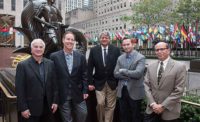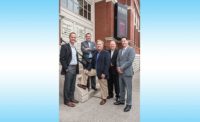With New York City being known as a place always overflowing with activity, it was appropriate the seventh annual American Supply Association/Supply House Times distributor roundtable interview took place at the historic Waldorf Astoria in Manhattan.
During the exclusive 90-minute interview, a blue-chip panel of ASA member distributors had no shortage of opinions and ideas when talking about topics pertinent to today’s PHCP-PVF industry.
In the January issue of Supply House Times, the panel discussed current market conditions, the adaption of technology and attracting new talent to the industry. Read here for Part 1 of the interview.
This time, distributors keep their foot on the pedal regarding topics such as new threats to the industry, distributor-manufacturer relationships, the viability of universal part numbers and thoughts on the value of being an ASA member.
This year’s panel featured:
-
Mike Abeling, President/CEO, Consumers Pipe & Supply, Fontana, Calif.;
-
John Howe, CEO, American Pipe & Supply, Birmingham, Ala.;
-
John Mills, President/CEO, WHCI Plumbing Supply, Union City, Calif.;
-
Jeff New, President, Mid-City Supply, Elkhart, Ind.; and
-
Randy Wool, President, Wool Plumbing Supply, Miami, Fla.
Question: What new threats/obstacles are out there that the industry should keep an eye on?
A majority of this discussion reverted back to some earlier topics, but as a whole produced plenty to think about. “Our major obstacle is finding people for our business and our customers’ businesses,” New said. “If we can find people we’ll be OK.”
Howe also went down the talent path. “It’s replacing an aging workforce,” he said. “We need to find new folks for the business. It’s all about people.”
Abeling, whose company is based in Southern California, lamented about the abundance of state regulations businesses in the Golden State must deal with. “For us with industrial PVF, the state environmental restrictions are chasing business out of California,” he said. “We’ve turned to commercial construction. Now, more than 50% of our business is commercial construction instead of industrial PVF.”
Wool noted companies must remain watchful of large online presences such as Amazon and Grainger in the construction space. “They have billions to invest and they can buy drones to deliver packages,” he said. “It’s out of our reach, it’s a major obstacle and they will get bigger and continue to do things we are not capable of doing.”
On the flipside, Howe said: “I don’t think it’s necessarily a bad thing we aren’t selling a higher percentage of our business on the internet because customers still want to talk to somebody. Our products aren’t as commoditized as the stuff bought on Amazon.”
Question: Is the concept of having universal part numbers in this industry a viable one?
Abeling referenced the electrical industry as one that’s had success with common UPC numbers. “One thing this industry has always been backward on is universal part numbers,” he said. “We’ve funded our spiff and spin over the years and tried to get everybody to talk the same language. A 3/4-inch elbow can have different numbers from different manufacturers for the same product. AD (Consumers Pipe & Supply is part of the AD buying group) is working on a database project that hopefully will bring all this information into one place. Right now, we’re nothing like the electrical industry where they all talk the same UPC.”
Wool added: “It’s amazing how our industry hasn’t united on this. We’ve been talking about it for 20 years. It should be relatively easy.”
Another panelist, who belongs to a different buying group, also heard about AD’s initiative. “What they are doing with data is something individually we couldn’t do because we don’t have enough money,” the panelist said. “It would cost millions. I hope it succeeds and I hope it’s something that could be shared with the industry down the line. It will help all the independent wholesalers who go up against these mega-companies.”
Question: What are relationships like between manufacturers and distributors these days?
Wool used the word “practicality” as a point of emphasis when answering this question. “Ideally it’s practicality when you talk about manufacturers and distributors getting closer,” he stated. “I feel like we each have our own agendas and unfortunately our distribution network is evolving to a place where wholesale-distribution is getting bypassed little by little in a changing marketplace. It’s the old value-added scenario. If we don’t have a purpose and they don’t need us, they will figure out a way to bypass us and cut costs out of the chain. We have to bring something to the table.”
New said current-day conditions are necessitating a closer working relationship. “The market requires us to get closer to each other,” he said. “As our numbers on the distribution side continue to shrink, partnerships are more important now than they ever were.”
Abeling added trust is a must in manufacturer relationships. “That’s the big word,” he said. “You need to push forward with vendors and get to a trusting relationship.”
Howe concluded: “If you aren’t adding value, you won’t be there.”
Question: Will there be any short-term consequence for the industry coming out of the recent presidential election?
The majority answer here was pretty straightforward — no. “We will survive and learn to adapt,” New said.
“If you follow the Beaulieu brothers (Alan and Brian, who deliver industry forecasts at ASA NETWORK events), they pretty much say it doesn’t matter who is in the White House,” Abeling said. “There are enough checks and balances where it won’t destroy the economy or the stock market. This industry will survive whatever happens. It likely will be a year-and-half after elections before anything gets done. If nobody can do anything and there’s gridlock, it’s probably a good thing.”
Wool closed the question with this parting shot. “On one hand I would say train wreck (this interview was conducted near the tail-end of the presidential campaigns) and on the other hand I agree with the consensus that it doesn’t really matter (who is president).”
Question: What benefits do you receive by being an ASA member?
New and Wool both expressed in pointed terms just how valuable their ASA memberships have been over the years. “To Mid-City Supply, ASA is survival,” New said. “Because of my involvement at the regional level and then at ASA, I met the right people to get us into the right buying group.Mid-City Supply would not be here today without ASA. The relationships I’ve made during my leadership days at ASA have helped my company in countless ways; from many little things to the overall big picture.”
Wool added: “We wouldn’t be sitting here right now exchanging best practices if it wasn’t for ASA. The annual ASA NETWORK is another chance to get together with peers, friends, manufacturers and reps. It’s relationship building. Relationships still mean a lot. I take my hat off to Mike Adelizzi (ASA executive vice president) and the ASA staff for bringing ASA to where it is today compared to what it was 10-15 years ago. They have done an admirable job.”
Abeling agreed the relationship side of ASA has been a major positive for him both personally and professionally. “The friends I’ve made here at ASA on the social side have led into the business side,” he said. “The educational component ASA has for employees is second to none and has come such a long way. We have two people in the ASA University Masters of Distribution Program and they love it.”
Howe also cited the excellence of the educational component. “We are heavy users,” he said. “We did away with our old performance management program. Every employee has an individual development plan in our company in terms of where you want to be in five years and how can we help you get there. And with every one of those IDPs there is something related to ASA training and ASA University.”
Mills loves the inclusiveness of ASA’s many programs, groups and activities. “We push ASA up and down our organization,” he said. “We send younger teammates to Young Executives. Our entire organization can network and leverage through ASA just like top executives can. ASA has something for everybody in this industry.”
This article was originally titled “New York state of mind” in the February 2017 print edition of Supply House Times










